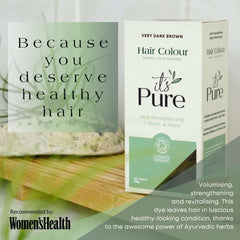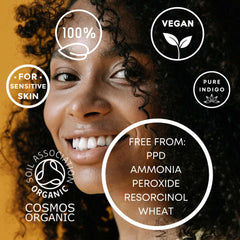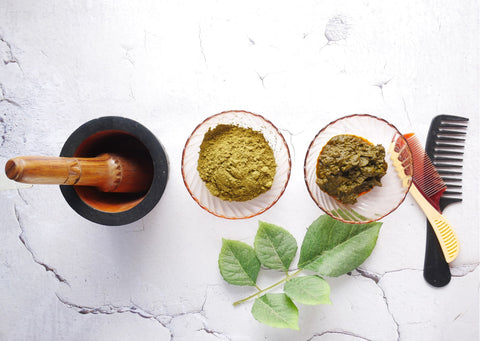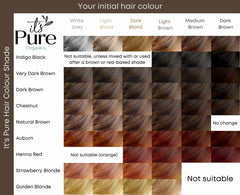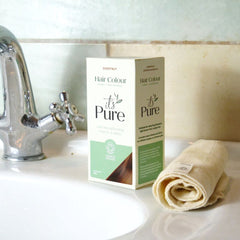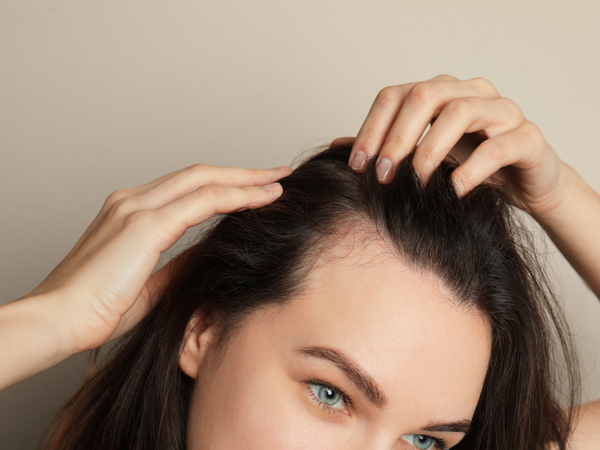Allergic to Hair Dye? - How Herbal Colours Might Help

There are many reasons why you might develop an allergy to mainstream hair dye. If you’re someone who enjoys the process of colouring their hair, or your colour is a big part of your identity, it can also feel like a huge loss.
You wouldn’t be alone. A study of Danish women found 75% colour their hair and the UK numbers are very close.
With that in mind, in this guide, we’ll explore alternatives – herbal hair colours – that may help you keep your colour without risking your health.
One of the most common reasons people discover our range of of It's Pure Organics Hair Colours is because they’ve developed an allergy to their mainstream colour.
It’s surprisingly common, especially if you use darker colours, which contain PPD (paraphenylenediamine), an ingredient so allergenic it is banned in the US but still allowed in the UK and Europe.
Our hair colours are free from chemicals, and are made up entirely of organic plant ingredients.
We’ll go through:
- How to tell if you’re allergic to your hair dye
- Common triggers for hair dye allergies
- PPD and how to tell if it is in your hair colour
- What Herbal Hair colours are
- How Herbal Hair colours may be safer for those with allergies
-
How to strand and patch test your hair for safety
How to Tell if You’re Allergic to Hair Dye
If you’re allergic to your hair dye, you may develop a condition called contact dermatitis.
If you’ve developed this, it will usually show up one to two days after your dye job. Symptoms may include:
- Patches of redness or soreness
- Itching and scabbing
- Blistering
- Eczema like symptoms
These symptoms are likely to increase in severity with repeated exposure and may cover the face, scalp, and neck. Behind the ears is a particularly common area to be affected.
You might also experience a condition called contact urticaria (swelling). This is a more severe reaction which causes quicker itching, localised areas of swelling and redness, and generalised swelling on the body. It may also lead to anaphylaxis.
Symptoms will start to occur minutes after exposure to the product, any may also settle down quicker (within a day).
Common Triggers for Hair Dye Allergies
Even if you’ve never experienced an allergy before, an allergy to hair dye can begin at any time, so it is vital you always do a patch test.
It’s worth knowing that the EU Scientific Committee assessed 46 common hair dye ingredients, finding that 27 substances were ‘sensitisers’, which means likely to cause allergies.
Further research showed reactions to 10 were extreme, 13 strong and four were moderate (no, we have no idea why they’re continued to be allowed to be used either, but that’s another topic).
The most likely ingredients to cause contact allergies were preservatives and severe reactions came from colour enhancers and in particular, PPD.
PPD and How to Tell if it is In Your Hair Colour
PPD (Para-phenylenediamine or black henna) is listed as one of the most common ingredients in darker hair dyes, found in more than 1000 hair dye formulations.
It is listed in this study as the most frequently used permanent hair dye component in Europe, North America, and East Asia.
It is an extreme sensitiser. If you’ve had a black henna (which isn’t actually henna at all, but made entirely of synthetic materials) tattoo at any point, you will almost certainly develop a hair dye allergy. And once you have become allergic, the symptoms will only worsen.
If you see the following listed in the ingredients on your hair dye packaging, it contains PPD. It is important to share with your hairdresser if you have a sensitivity too.
- P-phenylenediamine.
- Para-phenylenediamine.
- 4-aminoaniline.
- 1,4-benzenediamine.
- p-diaminobenzene.
EXPERT NOTE: If you suspect you have developed an allergy to PPD it is important you stop using hair dyes containing it immediately, as the risk of severe reaction is quite high.
What Herbal Hair colours are
Herbal hair colours are an alternative to the current mainstream semi-permanent and permanent options available now.
Mainstream permanent (oxidative) hair colours work by altering the structure of the hair. They open the hair shaft and replace the colour molecules, which is not reversible.
Mainstream semi-permanent (additive) hair colours work by temporarily staining the outside of the hair. They’re usually a little gentler, but rarely effective.
Herbal hair colours are mostly additive in nature, but more powerful than mainstream colours.
They usually contain natural ingredients like ‘true’ red Henna, Indigo and Cassia. All three are plant-based and have been used for thousands of years. (Red) henna bonds with the keratin in your hair creating a virtually permanent shade, whereas Indigo temporarily stains the outside of the hair, but more completely than a semi-permanent dye.
Cassia is also called ‘colourless’ or neutral henna, but when mixed with lemon juice adds a golden tone to light hair shades and shine to dark.
Henna is a red colour but can be cooled with the addition of Amla. Indigo is a blue-black dye. It is used in small quantities to darken henna to create a broader range of shades and tones. Other plant-based powder dyes like turmeric and beetroot can create nuanced shades.
If you have bleached hair, Henna-based herbal dye may not be for you (read why in our guide to bleach and henna here). But if you’re looking to cover grey, go darker, brighter or richer, a herbal hair dye may be a very good option for you.
How Herbal Hair colours may be safer for those with allergies
There are many reasons why herbal hair colours are safer for those with allergies.
- Herbal hair dyes usually come in dry powder form which means they will be preservative free. - Preservatives can be among the most sensitising ingredients.
- Similarly, fragrance is another major allergy trigger and henna-based powder dyes rarely have added fragrance.
- In contrast to several ‘natural’ hair dye brands, most henna brands, and most certainly It’s Pure, don’t use PPD. Its Pure dyes are also ammonia, hydrogen peroxide and resorcinol free.
- Henna has a long history of successful use on sensitive and reactive scalps. It has antimicrobial, antifungal, and anti-inflammatory properties that work to actively soothe the scalp whilst increasing shine. It’s not impossible to be allergic to herbal dyes – you can in theory be allergic to anything – but it is rare. Many It’s Pure customers are allergic to conventional hair dye but get on very well with our herbal colours. But we would always recommend that you patch test first (see below).
- At It’s Pure we also guarantee no impurities in our ingredients. We mix our herbal hair dyes on site in our eco-factory in Suffolk, using the highest quality single source herbs direct from the supplier. This means we can be confident in the quality of our blends, and that nothing untoward has found its way into the manufacturing process.
We’d always recommend choosing a certified organic hair dye. Soil Association standards restrict the use of harsh ingredients. If you choose a dye that, like It’s Pure, is independently certified, it means it has been pre-checked for chemicals that are known to be toxic. So there will be far fewer ‘sensitisers’.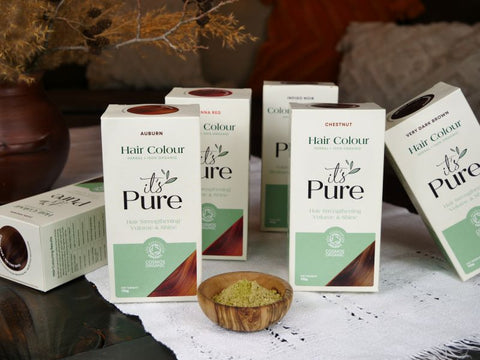
How to Patch Test Your Herbal Hair Dye for Safety
It’s simple to do a patch test, but you should allow a little time.
Just apply a small amount of dye on the inside of your elbow, wrist or behind the ear.
Make sure to cover with a small plaster to keep wet on the skin, and leave for up to 48 hours.
If any itching, redness or swelling happens, you may have a reaction to the hair colour.
We’re so committed to your safety; we have test sizes available for both colour checking and patch testing.
If you have any concerns about allergens, speak to our hair experts here >

